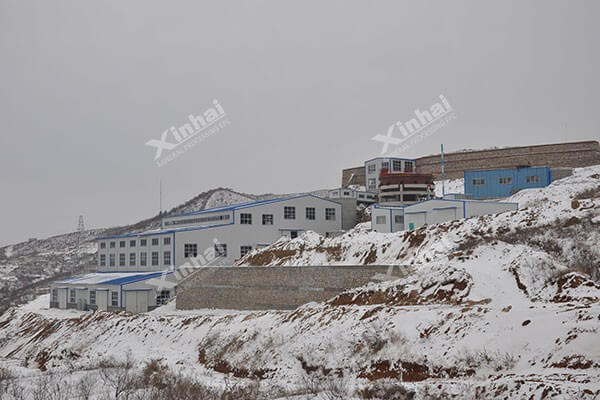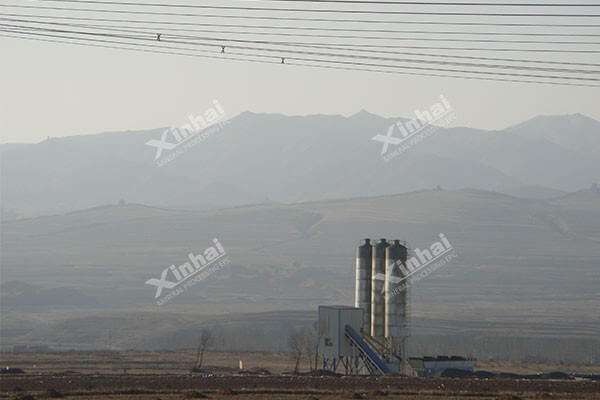

The Summary of Molybdenum Extraction Technology
2019-08-19 14:12:33xinhai
Molybdenum ore is a kind of rare metal with high economic value, which is widely used in many important industries because of its excellent physical properties.
According to different molybdenum mineral properties, the molybdenum processing methods are different, mainly including flotation process, floatation-magnetic separation-gravity separation process, flotation-electric furnace process.
The common molybdenum ores mainly include single molybdenite, molybdenum-contained polymetallic ore and oxidized molybdenum ore. The different molybdenum ores have various grade and property, which determines the molybdenum extraction methods are different. For example, talc-contained molybdenum ore or copper-molybdenum ore, highly oxidized molybdenum ore and the molybdenum ore with fine or ultrafine disseminated grain size usually have a grade of about 0.08%, these kinds of molybdenum ores are usually very difficult to separate. The molybdenum ore, whose grade is above 0.1%, is often associated with gold, silver, lead and other valuable metals, which has greater development and utilization value.
1. Singlemolybdenite extraction method
From most single molybdenum ore processing technologies, the typical single molybdenum extraction method is to make full use of natural floatability of the molybdenite, carry on rough grinding, rough separation firstly, then re-grinding and re-separation process. The practice shows that 1/17-1/23 molybdenite conjuncture can float well under the spraytex with high distilling range and wide distillation point. In the flotation process, due to the molybdenum content of molybdeniteis very low, so the precision of molybdenum must be high, so the molybdenite needs to be separated several times (generally 5-10 times), so as to make molybdenum ore get a high enrichment ratio.
In addition, due to the molybdenite is soft, so it is easy to be muddy in the fine grinding process, which has the obvious impact on the accuracy of molybdenumore. According to the natural floatability of molybdenite, the conjuncture produced by the coarse grinding need to be ground for many times, so that the conjuncture can be fully dissociated and then concentrated.
2. Molybdenum-contained polymetallic ore extraction method
Copper-molybdenum ore extraction method
Recovering the molybdenum from the copper-molybdenum ore is an important source of molybdenum production. Porphyry copper deposit belongs to copper-molybdenum ore. It is featured with the layered structure like molybdenite, good natural floatability, fine disseminated grain size, low grade of the raw ore, and high degree of symbiosis with pyrite and chalcopyrite. So it's harder and more complex to recover molybdenum.
To realize the separation of copper and molybdenum, the common mineral processing methods mainly include preferential flotation and bulk flotation. Among them,the bulk flotation method has a wide application. To put it simply, first copper and molybdenum concentrate are separated through the roughing, and then copper and molybdenum elements are separated from the obtained coarse concentrate. Due to molybdenum molybdenite, sulfide ore are easy to float, so it is easy to obtain copper molybdenum concentrate. However, some separation methods are required to separate the copper and molybdenum in copper and molybdenum ore:
• Conventional flotation method: To obtain the molybdenum, the flotation of copper must be suppressed. The conventional flotation method usually floats aluminum and suppresses copper. Currently, there are two types of reagents used to inhibit copper ore, one is organic reagents, such as ethyl mercaptan; And the another is inorganic reagents, such as cyanide, sodium sulfide and so on. In order to enhance the flotation effect on molybdenum minerals, small amounts of non-polaroil can also be added. For example, the water glass and other regulators can be used to inhibit the dispersion of pulp and gangue minerals, which can improve the grade of molybdenum concentrate, and obtain the high-quality molybdenum concentrate after several separation.
•Nitrogen charging flotation method: At present, people pay more attention to the environmental protection. Using the cyanide copper inhibitors will cause a certain pollution to the environment, so the majority of molybdenum ore dressing plant mainly adopts the sulfur sodium hydride or sodium sulfide as the copper inhibitors, but the sodium sulfide has strong reducibility, which can be easily oxidized by the dissolved oxygen of the pulp in the flotation process. Besides, the using of reagent dosage is also bigger in the practice, using the nitrogen charging flotation method makes effective control in the using of inhibitors.
Pulsating high gradient magnetic separation method. It is an effective method to separate fine minerals with weak magnetism, which is widely used in the separation of manganese ore, weak magnetite. High gradient magnetic separator has high frequency vibration, and adopts the technology of recoil concentrate, swivel vertical rotation. The non-magnetic minerals mixed in the ore are separated through the action of a magnetic field, and the concentrate is absorbed in the cylinder surface as the form of magnetic chain or magnetic regiment, and gradually transmitted to magnetic edge. Under the action of flushing water, the concentrate is discharged to concentrate slot. Molybdenite is a kind of non-magnetic mineral, so this method cannot be used, while the copper-molybdenum is a kind of weakly magnetic, which can be treated with pulsating high gradient magnetic separation method for copper-molybdenum separation.
Other molybdenum-contained polymetallic ore extraction methods
For the gold-molybdenum-lead-sulfur polymetallic ore with the quartz, the mixed coarse concentrate can be produced by the flotation method first, and the gold is recovered by the cyanidation leaching of the coarse concentrate, then the molybdenum flotation is carried by the tailings leaching for obtaining the molybdenum concentrate, the lead-sulfur is separated from the tailings of the molybdenum concentrate flotation, then the lead concentrate and sulfur concentrate are obtained.
For the low-grade tungsten-molybdenum-bismuth ore, the molybdenum-bismuth mixed separation and re-separation process can be used. After the molybdenum-bismuth mixed separation, the mixed coarse concentrate is obtained, and then molybdenum bismuth-sulfur separation and molybdenum-bismuth separation can be carried out.
3. Oxidized molybdenum ore extraction method
Generally, the long-term wind erosion, rain, sunshine will make the upper part of molybdenite deposit oxidize, part or most of molybdenum sulfide are oxidized as oxidized molybdenumor molybdate. The oxidized molybdenum is a kind of natural hydrophilic mineral, the various oxidized molybdenum minerals have different physical and chemical properties, and the disseminated grain size of the mineral is fine, so it is a kind of refractory molybdenum mineral. For this type of molybdenum ore, flotation and other mineral processing methods are usually jointly used for separation.
Here are the several common molybdenum ore dressing methods. It is recommended that the miners entrust the mineral processing service provider with the mineral processing test qualifications to carry on the mineral processing test in advance, determine the chemical composition of the raw ore, mineral composition, ore structure, composition of particle sizes, density of the raw ore, grindability of ore, then select the scientific and reasonable molybdenum ore dressing methods depending on the result of mineral processing test and the practical situation of the molybdenum ore dressing plant.
1. Xanthate can be used as the collector for molybdenum sulfide flotation
The reagent is mainly y-89 series, and belongs to the xanthate with branch chain and long carbon chain, which can not only achieve the strong collection effect, but also greatly improve the recovery of associated metals in minerals. However, this kind of reagent also has poor selectivity, so in the process of sulphur separation, the grade of concentrate will be affected after the consumption of lime.
2. New type aero float collector
This reagent can achieve the collection of copper sulfide (molybdenum) ores and gold, silver minerals. But the phosphates with the properties of single sulfur are only available in weak alkaline or neutral conditions.
3.New Type thiol collector
As the thiol derivative, this reagent can eliminate the stink caused by the low-grade thiol, and realize the dissolution efficiency in the cold water, so it is widely used in the industrial production.
Shandong 1300tpd molybdenum ore dressing project

Xinhai solution: one stage open-circuit crushing - self-grinding, ball mill two stages grinding and classifying - differential floatation, tungsten separation from the flotation tailings - concentrate dehydration - tailings treatment.
Inner Mongolia 2000tpd molybdenum ore dressing project

Xinhai solution: Two stages a closed-circuit crushing and screening - three stages closed-circuit grinding - flotation (one roughing, two scavenging, seven cleaning, two cleaning and scavenging) - concentrate dehydration.